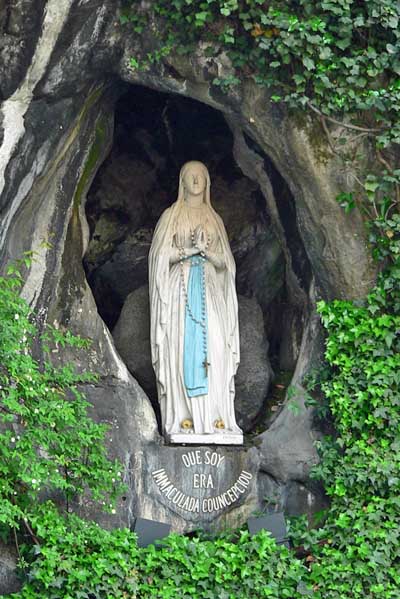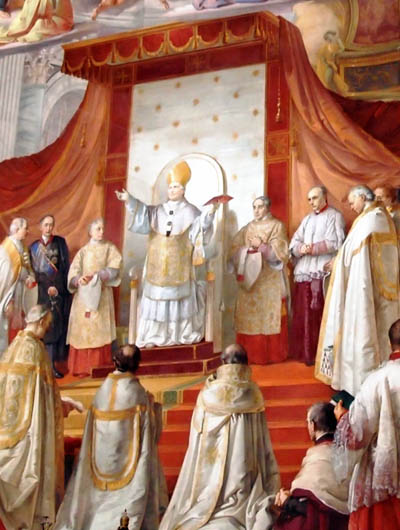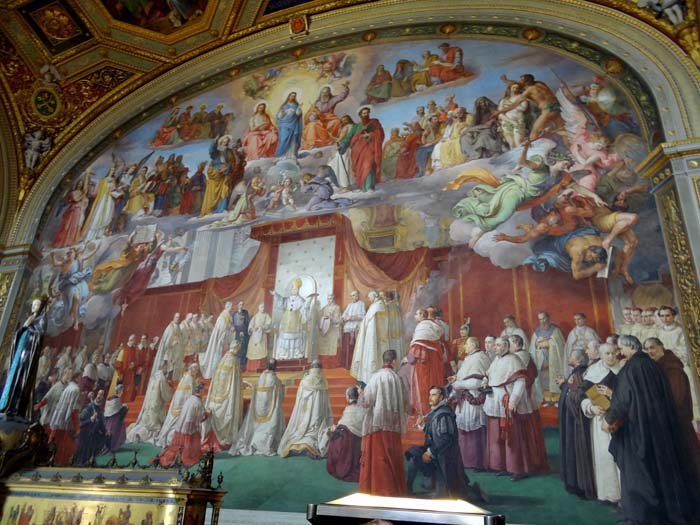Titles of Our Lady from the Litany of Loreto
Queen Conceived without Original Sin
 If there is one doctrine of the Catholic Church which is misunderstood and misrepresented outside the Church, it is the doctrine of the Immaculate Conception. Many who laugh at the idea of the fall and original sin, and therefore are forced to claim their own immaculate conception, refuse to grant that privilege to Mary. It is hard to understand their animosity to Her. They are afraid to grant any privileges to Her. She, they declare in effect, is no better than themselves, yea worse, and they like to believe that Jesus not only did not honor Her, His Mother, but even humiliated and insulted Her. There is no logic in them. Their whole scheme of argument is this — "the Catholic Church honors Mary, therefore, we, to show our antipathy to the Church, must belittle Her." But the truth is, reverence for the Most Holy Mother of God is a mark of a true follower of Her Divine Son.
If there is one doctrine of the Catholic Church which is misunderstood and misrepresented outside the Church, it is the doctrine of the Immaculate Conception. Many who laugh at the idea of the fall and original sin, and therefore are forced to claim their own immaculate conception, refuse to grant that privilege to Mary. It is hard to understand their animosity to Her. They are afraid to grant any privileges to Her. She, they declare in effect, is no better than themselves, yea worse, and they like to believe that Jesus not only did not honor Her, His Mother, but even humiliated and insulted Her. There is no logic in them. Their whole scheme of argument is this — "the Catholic Church honors Mary, therefore, we, to show our antipathy to the Church, must belittle Her." But the truth is, reverence for the Most Holy Mother of God is a mark of a true follower of Her Divine Son.
Others confuse the Immaculate Conception with the Virgin Birth. The most uneducated Catholic knows the difference (yet, after Vatican II, there are many so-called Catholics who do not). The Virgin Birth has reference to Christ. It means that when the Word of God became Man, Incarnate, His Body was formed of the flesh of the Virgin Mary alone, without any intercourse with man, by the Holy Ghost. Before the Birth, in the Birth, and after the Birth, His Mother remained a Virgin, knowing not man.
The birth of the Blessed Virgin Mary was not a "virgin birth." Her parents, Ss. Joachim and Anne, cooperated with God in the formation of Her body. This is the physical aspect of conception. But the doctrine of the Immaculate Conception is focused primarily on the spiritual aspect—the creation of Her holy soul by God and its infusion into her body. As Pope Alexander VII declared centuries ago: "Concerning the Most Blessed Virgin Mary, Mother of God, ancient indeed is that devotion of the faithful, based on the belief that Her soul, in the first instant of its creation and in the first instant of the soul's infusion into the body, was, by a special grace and privilege of God, in view of the merits of Jesus Christ, Her Son and the Redeemer of the human race, preserved from all stain of original sin. And in this sense have the faithful ever solemnized and celebrated the Feast of the (Immaculate) Conception" (Apost. Const. Sollicitudo Omnium Ecclesiarum, Dec. 8, 1661).
When Adam and Eve were created and their souls infused into their bodies, they were without sin, hence immaculate. But they fell, sinned, lost the state of sanctifying grace, and would have been banished forever from the sight of God, only that God in His Infinite Goodness promised to redeem them, to take them back, and in due time did send His Only-Begotten Son to become Man and redeem them. But meanwhile every descendant of Adam and Eve, by that sin of the first parents, contracted the debt—contracted original sin. At the moment a soul is infused into the body, it is deprived of holiness, deprived of original justice; the soul is spiritually dead, and in the state of enmity with God. But it is not a hopeless case. By the mercy of God, it is possible, in view of the merits of the Redemption, for this soul in the state of original sin to be repaired, to be spiritually regenerated, to receive sanctifying grace and all the virtues and gifts which that state brings, and to become again an heir of Heaven. This is what God does for us in Baptism.
It was different with Mary—in such a way that She was a unique exception. Mary was indeed redeemed by God, but there is a difference between Her case and ours. God redeemed Her, but by an anticipated Redemption. He let sin come into our souls and then later took it away; but He prevented sin from coming into Her soul. He redeemed us by reparation; He redeemed Her by preservation. A homely example, though not entirely accurate, may help to explain this. I have a sheet of white paper. My pen drops a blot of ink upon it. Then I erase it and make the paper clean again. Or, I see the drop of ink about to fall, and to prevent it dropping on the paper I turn the pen aside and let the drop fall on a blotter, or somewhere off the paper. In one case I clean the paper by reparation, in the other I keep it from becoming unclean by prevention, or preservation. Thus Mary was preserved from getting the blot of sin; was sanctified at Her creation.
 So that the essence of the doctrine of the Immaculate Conception is the absence of all stain of original sin. This is the definition of the Church: "We pronounce and define that the doctrine which holds that the Blessed Virgin Mary, in the first moment of Her Conception, by a singular privilege and grace of Almighty God, in view of the merits of Christ Jesus Our Savior, was preserved immaculate from all stain of original sin, is revealed by God and therefore is to be firmly and confidently believed by all the faithful" (Pope Pius IX, Apost. Const. Ineffabilis Deus, Dec. 8, 1854).
So that the essence of the doctrine of the Immaculate Conception is the absence of all stain of original sin. This is the definition of the Church: "We pronounce and define that the doctrine which holds that the Blessed Virgin Mary, in the first moment of Her Conception, by a singular privilege and grace of Almighty God, in view of the merits of Christ Jesus Our Savior, was preserved immaculate from all stain of original sin, is revealed by God and therefore is to be firmly and confidently believed by all the faithful" (Pope Pius IX, Apost. Const. Ineffabilis Deus, Dec. 8, 1854).
There is this to be added to the consideration of Her Immaculate Conception: when we are freed from original sin by Baptism the moral effects of Adam's sin are removed, but the physical consequences, pain and disease and death, the struggle between good and evil, remain. But by Her Immaculate Conception, there never was any sin, hence never any concupiscence, disease, or necessary death. She was all holy, with a supremacy of sanctity.
The Immaculate Conception, defined December 8, 1854, is of course not a new teaching in the Catholic Church. Though not declared explicitly, it was always taught implicitly. When it was defined, it was to be believed by all with explicit faith, that is, "as a distinct and separate dogma, no longer (merely) involved in the general belief of what the Church teaches" (Cardinal Wiseman). Implicitly the doctrine of the Immaculate Conception was contained in that of Her Divine Maternity and Her Perfect Purity. We have already seen, in considering other titles of Hers, the numberless "all holy," "all pure" titles the Church has given to Her. What else can they mean but Her absolute sinlessness at all times, which includes Her Immaculate Conception?
That has always been the belief of the faithful of the Catholic Church. Pope Pius IX tells us, "The Fathers and writers of the Church, well versed in the heavenly Scriptures, had nothing more at heart than to vie with one another in preaching and teaching in many wonderful ways the Virgin's supreme sanctity, dignity, and immunity from all stain of sin, and Her renowned victory over the most foul enemy of the human race" (Ibid.) God sometimes allowed controversy on the part of some theologians, as has happened so often in the history of the Church, but this was in order that the truth might be defined more explicitly.
Innumerable popes had upheld the belief in the Immaculate Conception, but things began to come to a head under Gregory XVI. He granted to the churches of France, America, England, Germany and Italy, at their request, an indult to introduce into the Preface of December 8 the words et te in Conceptione Immaculata, as the Franciscans had it. Much was contributed to the cause by the rapid spread of devotion to the Miraculous Medal, with its—"Mary, conceived without sin," revealed to St. Catherine Labouré, and also by the sensational conversion, by means of the Medal, of the Jew Alphonse Ratisbon. To Pope Gregory petitions came from all over the world for the dogmatic definition of the doctrine. It was a spontaneous movement. The movement so increased under Pope Pius IX, that he felt impelled to issue an encyclical to all the Bishops of the Church, February 2, 1849, asking them to let him know their own sentiments and the sentiments of their clergy and people. He had appointed a Council of twenty theologians to weigh the question thoroughly and report on all the authorities they could get from ancient writers, liturgies, and ecclesiastical documents. Then a special commission of theologians was appointed. They reported that the doctrine of the Immaculate Conception could be dogmatically defined, and that it was seasonable to define it. Six hundred and two letters were received from Bishops all over the world, expressing their belief in the Immaculate Conception; only a few of them questioning the opportuneness of defining it then. Wiseman tells us that sovereigns, heads of religious orders and innumerable others, wrote letters, enough to fill nine octavo volumes. All over the world Masses were said, people prayed, received Holy Communion, for the cause. The Pope invited to Rome Prelates to represent the hierarchy of every country. They came from all over the world, representing fourteen different languages.
At eight o'clock on the morning of December 8, 1854, all were gathered in the Sistine Chapel. Soon the Pope, with his court, arrived. One hundred fifty-two Bishops in silver copes and white miters, fifty-one mitered Cardinals, were in the procession to St. Peter's, where nearly forty thousand people were gathered. After the Gospel the Pope began to read the decree, his speech broken by his tears and sobs, so great was his emotion. Cardinal Wiseman says there was scarcely a dry eye in the congregation. Out in the city cannons roared, bells rang, proclaiming to the world that the Vicar of Christ had just defined the Immaculate Conception. A striking incident is related by the same Cardinal Wiseman. For several days, up to the evening before the eighth, there was a gloomy atmosphere, torrents of rain, and, the day after, the same conditions prevailed, but on December 8 the sky was serene and beautiful, the sun shone forth in splendor.

The Apostolic Constitution of Pope Pius IX—Ineffabilis Deus—defining the dogma, is one of the great documents of the Church, a mine of learning and devotion to all ages to come. Every Catholic should read it in its entirety.
The title of Our Lady under Her Immaculate Conception has a special appeal to Americans, since we are under Her special patronage. Many nations have been consecrated to the Immaculate Conception. As long ago as 1615, Spain and its dependencies were placed under the Immaculate Conception. We are told that even today Spaniards greet one another with, "Ave María Purísima—Hail Mary Most Pure!" and the answering greeting is, "Sin pecado concebida—Conceived without sin!" At one time every artist had to take an oath of belief in the dogma. In 1650 the Blessed Virgin, under the title of the Immaculate Conception, was proclaimed Patroness of Ireland.
When Alexander O'Reilly came to Louisiana, in 1769, as Spanish Governor of the Province, he made all the officials take this oath: "I swear before God on the Holy Cross and the Evangelists to maintain and defend the mystery of the Immaculate Conception of Our Lady, the Virgin Mary." America belongs in a special way to Our Lady, from north to south, from east to west. Every missionary to our shores brought Her with him. Rivers and lakes were mapped out under Her name. Settlements were called after Her, so that America was Our Lady's dowry long before it was a nation. The Jesuits, Franciscans, and others had remembered that one of their principal reasons for existing was to bring honor to the Mother of God.
Mary was several times chosen Patroness of the United States, but in the Sixth Provincial Council of Baltimore, May, 1846, devotion to the Immaculate Conception was solemnly discussed by the American prelates. On May 13 they decreed: "The Fathers, with ardent desire and with unanimous applause and consent have chosen the Blessed Virgin conceived without original sin as the Patroness of the United States..." the decree was approved by the Holy See on February 19, 1847. Permission to add to the Litany the title, "Queen Conceived without Original Sin" had already been granted on September 13, 1846.
So Mary, in the definition of the Immaculate Conception, was crowned under one of Her loveliest titles. Her apparition at Lourdes a few years later, 1858, and Her declaration to St. Bernadette—"I am the Immaculate Conception"—was a further proclamation of Her delight in this title. It is a title so dear to every Catholic, the glorification of our Mother. And so we sinners pray for the intercession of the sinless one: "O God, Who by the Immaculate Conception of the Virgin didst prepare a worthy dwelling-place for Thy Son, we beseech Thee, that Thou, Who through the foreseen death of that same Son of Thine, didst preserve Her free from all stain, wilt grant that we also by Her intercession may come to Thee, through the same Christ Our Lord… Amen."
Back to "In this Issue"
Back to Top
Contact us: smr@salvemariaregina.info
Visit also: www.marienfried.com


 If there is one doctrine of the Catholic Church which is misunderstood and misrepresented outside the Church, it is the doctrine of the Immaculate Conception. Many who laugh at the idea of the fall and original sin, and therefore are forced to claim their own immaculate conception, refuse to grant that privilege to Mary. It is hard to understand their animosity to Her. They are afraid to grant any privileges to Her. She, they declare in effect, is no better than themselves, yea worse, and they like to believe that Jesus not only did not honor Her, His Mother, but even humiliated and insulted Her. There is no logic in them. Their whole scheme of argument is this — "the Catholic Church honors Mary, therefore, we, to show our antipathy to the Church, must belittle Her." But the truth is, reverence for the Most Holy Mother of God is a mark of a true follower of Her Divine Son.
If there is one doctrine of the Catholic Church which is misunderstood and misrepresented outside the Church, it is the doctrine of the Immaculate Conception. Many who laugh at the idea of the fall and original sin, and therefore are forced to claim their own immaculate conception, refuse to grant that privilege to Mary. It is hard to understand their animosity to Her. They are afraid to grant any privileges to Her. She, they declare in effect, is no better than themselves, yea worse, and they like to believe that Jesus not only did not honor Her, His Mother, but even humiliated and insulted Her. There is no logic in them. Their whole scheme of argument is this — "the Catholic Church honors Mary, therefore, we, to show our antipathy to the Church, must belittle Her." But the truth is, reverence for the Most Holy Mother of God is a mark of a true follower of Her Divine Son. So that the essence of the doctrine of the Immaculate Conception is the absence of all stain of original sin. This is the definition of the Church: "We pronounce and define that the doctrine which holds that the Blessed Virgin Mary, in the first moment of Her Conception, by a singular privilege and grace of Almighty God, in view of the merits of Christ Jesus Our Savior, was preserved immaculate from all stain of original sin, is revealed by God and therefore is to be firmly and confidently believed by all the faithful" (Pope Pius IX, Apost. Const. Ineffabilis Deus, Dec. 8, 1854).
So that the essence of the doctrine of the Immaculate Conception is the absence of all stain of original sin. This is the definition of the Church: "We pronounce and define that the doctrine which holds that the Blessed Virgin Mary, in the first moment of Her Conception, by a singular privilege and grace of Almighty God, in view of the merits of Christ Jesus Our Savior, was preserved immaculate from all stain of original sin, is revealed by God and therefore is to be firmly and confidently believed by all the faithful" (Pope Pius IX, Apost. Const. Ineffabilis Deus, Dec. 8, 1854).
